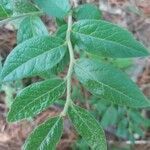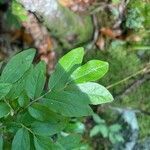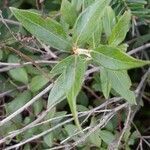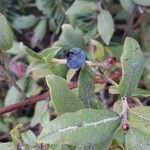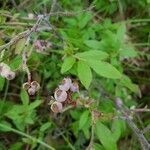A low bush. The upright shoots can be 10-110 cm high. The plant is hairy. There is a soft downy covering on the twigs and leaves. The leaves are long and narrowly oval. They are 2-4 cm long and 1-1.5 cm wide. They are green and downy on both sides and do not have teeth along the edge. The plant loses its leaves during the year. The flowers are white or pale pink. The fruit is blue and 5-8 mm across. The fruit have hairy stems. They occur in clusters.
Colonial shrubs 2–5 dm; bud-scales sharply acute; lvs thin and soft, elliptic to lance-elliptic, 1–3(–4) cm, half or a third as wide, entire, softly hairy beneath, not glaucous; cor broadly cylindric, 4–5 mm, white or tinged with pink; fr blue-glaucous, 4–7 mm; 2n=24. Moist or dry soil and bogs; Lab. to B.C., s. to Pa., Ind., ne. Io., and Minn., and in the mts. to Va. and W.Va. May–July. (V. canadense; Cyanococcus c.)
